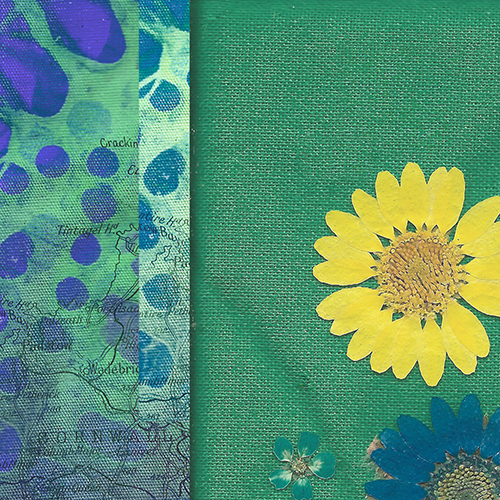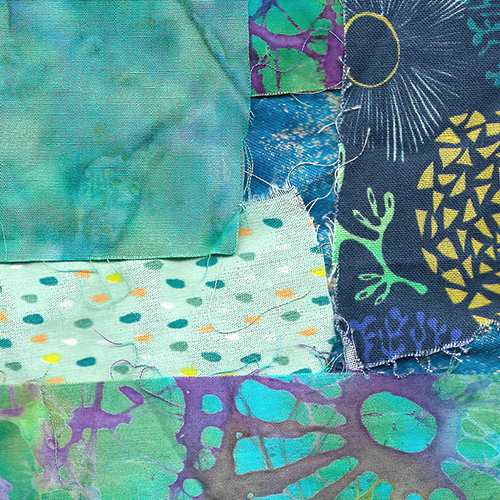Boscregan
Boscregan
Non-fiction
by Tim Martindale
It was autumn, and there were few trees for shelter on the exposed, south-west peninsula in Cornwall that is known as Penwith; only the small, stunted woods that cling to the steep valleys where streams cut their way to the sea. The season was marked by a succession of gales and rain-battered days, occasionally lifted by the odd fresh and luminescent day with the cliffs bathed in sunshine, gulls and fulmars flying low over the waves out at sea, chasing the shoals of mackerel that come in with the swells. One rather more murky morning, I walked down onto Botallack cliffs through the old mine workings to do a litter-pick in the mizzle – that peculiarly Cornish blend of fine rain and mist that can hang over the coast and moors for days at a time, till it becomes hard to tell where land and sea begin and end.
It was early on in my new job as a ranger, based at a National Trust site at Botallack, near St Just, helping to look after an area of coastline which stretches from Land’s End to the village of Pendeen on the north coast. A rugged stretch of cliffs, old mine workings, small farms, coves and villages of low granite houses, sandwiched between the sea and the brooding massif of the moors that runs down through the spine of Penwith. As I descended that morning below the line of fog, the heather-clad cliffs and twin mine engine-houses known as ‘the Crowns’ perched on the edge far below came into clear view, seemingly empty and forsaken of people. The low winter sun that was now dipping below the clouds cast a luminous grey-gold light over the ocean where gannets dived.
Following a random path down the cliff face, I stumbled across the entry to the Cargodna mine shaft, where a memorial commemorates the Wheel Owls disaster. On 10th January 1893, about forty men and boys were underground when the shaft flooded with water. The mine surveyor had used old mine charts and had failed to account for magnetic declination (the variation of magnetic north over time), throwing his calculations out. They had excavated into an old, flooded shaft running adjacent to Cargodna. Nineteen men and a boy were killed, and their bodies remain in the mine to this day. As I walked on along the cliff path, I imagined voices here, spirits of the dead, miners entombed in their sea-girt graves, in tunnels that lay under my feet in these cliffs and out under the sea, voices filling this realm where only they and the seagulls cry. Exploring the warren of paths and lanes, sheltered in places by overgrown stone hedges, it wasn’t hard to imagine how, not so long ago, weary miners once trod the same paths on their way home to St Just and other nearby villages, after their shift of long, dark and hot hours toiling below ground. I felt sure they must have found some comfort in the small birds darting between hedges that in spring and summer would have been full of evening song.
Although the history of this place felt, at times like this, almost tangible in the sea mist-laden air and the lichen-clad granite stone ruins of the mines, it is a history that I couldn’t claim any close personal connection to. I’d grown up in Cornwall, but not in Penwith. Mine was a rural upbringing, but on small farms further east and inland – the son of a farmer, not a fisherman or a miner, and for the majority of my childhood, brought up by my mum, a social worker, and my stepdad, a stone mason. I left at eighteen to go to university in London and had periodically come back, as a juvenile peregrine will return to the place of its birth long after having fledged, until it has firmly established a territory of its own. This latest return had been presaged by the breakdown of a long term-relationship, followed by a painful love affair, and a struggle to find direction and stability in life after the completion of a long period of academic study. Instead, I was caught up in that common trap of people today in their twenties and thirties and without means – of high rent and low paid and relatively unfulfilling labour. But probably the roots of the pervasive anxiety and lack of confidence that shadowed me stemmed back to long before all that.
Seeking a fresh start, I left my job as a bookseller in a small town in Sussex nestled in the South Downs. It was a place where I had only just begun to build a new life after running away from London, and one which I had a growing affection for. Yet I was acutely aware I had no history or roots there, no deep-rooted familial bond to the landscape around me. And this was something I had a profound longing for.
Having returned to Cornwall, the chance of a job working for the National Trust as a ranger seemed like just the opportunity I was looking for: to reconnect and ground myself, to find a new path – one in which my connection to the landscape around me might be less a cerebral, romantic and nostalgia-riddled one, instead grounded in the practical skills and knowledge of how to look after and care for the land and for nature. It was to prove a difficult journey. It isn’t always easy to return to a place of origin, especially with complex family relationships and troubled histories to navigate. Living in a caravan on my dad’s farm, with only this temporary job to hold me above water, I was aware of the precariousness of my position should things not work out.
So far, the job hadn’t been quite all I had imagined it to be. There was the long list of relatively mundane maintenance tasks that had been neglected since my predecessor went on long-term sick leave. Then there had been the ominous threats made on social media against staff and volunteers by one or two extreme locals. An atmosphere of mistrust had developed around the National Trust’s presence and work here, especially since the filming of Poldark. The latest TV series, in which the Crowns in particular featured as a prominent backdrop, had brought many more visitors to the area, but had also aggravated some locals, who believed that the National Trust was an outside corporate intrusion on the place, seeking to ‘cash in’ on the area’s history and natural beauty.
In the early days of my relatively brief ranger apprenticeship, this atmosphere of conflict only served to exacerbate my sense of alienation and unbelonging, the opposite of what I had come back to Cornwall to seek. However, part of my role as a ranger, and of the National Trust more generally, was to help conserve not only the wildlife and ecology of the area, but also the distinctive material remains of its history: written like a palimpsest in the network of ancient pathways and stone boundaries that criss-cross the landscape. Not only markers of history, careful upkeep of these features enables visitors and locals alike to continue to form and maintain their own connection with the land. Helping to repair them would become my way of forming a bond with it too.
*
Many of the hedges in Penwith date back to the Bronze Age and are older than the Egyptian Pyramids. Others are more recent, having been thrown up by miners who were often also small-scale farmers. Some of these are over six feet high and built with huge boulders at waist and even shoulder height. I had to marvel at the strength and technique it took to get them up there without mechanical assistance. Some were dry-stone walls, others built in the traditional Cornish style, typically from granite with a core of earth in the middle. This is what distinguishes a Cornish ‘hedge’ from a stone ‘wall’, as found in other parts of the country, such as Yorkshire and the Lake District. The earthen core not only binds the stone but becomes a seedbed for trees, shrubs and flowers, so that in time it becomes a living hedge, home for many plants and animals.
My interest in Cornish hedging had begun seven or so months previously as a full-time volunteer ranger working at Godolphin, a historic estate east of the Hayle River. There I had discovered a love for working with stone, repairing hedges that formed the field boundaries and that had collapsed in places – under the weight of a fallen tree, livestock, or just time and weather. After a long estrangement, I had reconnected with my stepfather, a stonemason and quarryman, who ran a business supplying fine architectural granite. Hearing of my new-found passion and my need for some cash to support my volunteering he set me up with his friend Mark, an expert Cornish hedger who agreed to take me under his wing. In return for my help and in the little time we had while I was labouring one day a week for him, he taught me what he could of the craft.
A small, quiet, but energetic man, in his mid-sixties I guessed, Mark seemed to me to resemble the sparrows that flitted around his yard at my stepfather’s quarry. He fed the birds every day, whistling to gather them to him, throwing some seed amongst the old pieces of granite he was collecting – milling stones, bird baths, cattle troughs, some dating back to medieval times. An ex-miner, I quickly learnt that Mark was a humble and principled character – a lover, like my stepfather, of nature, of old things and values, of hard work, history, heritage and craftsmanship, of friendship and helping one another out, putting people before money. On my first day out with him we drove around the narrow Cornish lanes in his small flatbed builder’s van, looking at examples of hedging that he thought were particularly well-constructed and others that he thought were bad. It wasn’t just that a Cornish hedge should have a gently concave face, wide at the bottom, tapering in towards the middle, before gently widening again towards the top. The outward facing stones should be clean and flush with each other, tightly packed with earth and with no holes or gaps. Longer ‘key stones’ should be laid with the length going back into the hedge to give it strength.
As pleasant as these days out with Mark were, they were also days of persistent, low-level frustration, like working on a giant jigsaw puzzle, picking through piles of stone, trying to find the perfectly shaped one to fit next to the ones already laid, struggling to learn fast enough to meet my own and Mark’s high expectations. Yet I found the flow and pattern of it calmed my mind, typically prone to anxiety. I could lose myself in total, focused attention on the task at hand. And I enjoyed being with Mark working on a hedge in some quiet out-of-the-way spot. We’d have our tea and packed lunches (or ‘crib’ as he called it, using the old miners’ term) sitting in his van, and we found a common interest in history. He was a gentle and good-natured chap and I felt privileged that he agreed to take the time to try and teach me what he knew.
Knowing of my enthusiasm for hedging, the Lead Ranger asked me to lead a project to repair a section of hedge on a tenant farm, and in the process share the skills I was learning with some of the younger volunteer rangers. Working alone one weekend morning, as my role often entailed, I drove the Land Rover out across the fields of Boscregan, a remote farm that looked out to sea between Cape Cornwall and Land’s End, with Bob Marley playing loud on the stereo. Earlier in the week, I had been out there working with a couple of the volunteers. As much as I enjoyed their company and questions, teaching them the modest amount I had learnt about hedging, it was trying sometimes to get them to stop chatting and larking around, and instead to focus on the work at hand. I was looking forward to cracking on with the job on my own for the day.
The fields had been sown with an arable crop and allowed to go to seed to provide food for the birds. The crop was interspersed with weeds and wildflowers such as corn marigolds, a riot of colour in spring and early summer, but now nodding lifelessly in the autumn sea breeze. A monotone of pale gold and browns under a low grey sky, to a casual observer’s eye it might have looked as if the farm had been allowed to go to wrack and ruin, gradually being overcome by nature again. But this was all part of the Trust’s conservation management plan for this tenant farm. Buzzards and kestrels soared, hovered and dived in the sky around me as I worked. Unfortunately, the stone hedges had also been long neglected and allowed to go to ruin by the tenant farmer, as the hooves of cattle climbing the hedges to reach more inviting grass on the other side gradually took their toll. The stone we were using for the repairs was a mixture of reclaimed granite from around the farm and some we had brought in from further afield, all Penwith stone. Some of the stone on site was of the quality known as growan, a local dialect term for decomposed granite, especially common in Penwith, for here the granite has often lain on or close to the surface of the ground for a very long time, exposed to the eroding action of the weather. Some of it was so crumbly that we could practically break it apart with bare hands or a tap of the lump hammer. It was ideal for using in the core of the hedge, alongside earth.
The fields ran right to the cliff-edge, to the headland where long-horned cattle grazed, and the surf curled and broke. Later that morning, the weather began to roll in, a thick sea mist that became heavier and more persistent till it became rain, enclosing me in my own little world. With the roar of the surf, it was almost as if I was at sea, and I felt nauseous and sick with it. That, and an undefined anxiety, as I slipped around in the mud, attempting to heave the big grounder stones into place (the boulders that would provide the foundation for the hedge). The wet and weathered rock tore at my hands as I went backwards and forwards with my wheelbarrow of earth to backfill the hedge, tamping in the soil around the stones with the butt of my lump hammer. Eventually I was forced to take shelter in the Land Rover, and I had my tea and sandwiches as the rain ran down the windscreen. I texted my girlfriend Nika, who lived far away in Sussex, to tell her how much I was missing her. Our relationship, still tender and new, had sprung up since I had moved away from Sussex and returned to Cornwall, but already I felt keenly her absence between visits. Receiving a heartfelt message in return, I found tears running down my face. How far away she felt and how I longed to have her beside me, to be able to share all this wild and raw beauty with her, even on a day like today.
After lunch, the work began to flow better, and I found a rhythm and a calm as I took pleasure in finding the stone that would fit just right next to the one laid before. The weather was beginning to clear too. I lost track of time and after a couple of hours, I stopped to rest and have another cup of tea, finding a grassy spot to sit and lean against the old, rambling hedge. Before me lay a silver, mist-shrouded sea, sunlight moving across the waves, and the string of rocks that jutted out from the sea, known as the Longships, fading into obscurity. A buzzard seemed to hover over the fallow corn crop and the dead marigolds. Had he learnt to do this from the kestrels, one of which hovered nearby, I wondered.
That day, my body and will pushed against stone, until some internal resistance in me was overcome, and I was free to receive these gifts, the mystery of this place, waves cresting the Longships and spotlights of sun searching the grey sea. My eyes and ears searched too, picking out a tumble of stones on the headland – a cairn or Iron Age cliff castle, a deer grazing in a neighbouring field, the mewing cries of a family of buzzards. Suddenly I felt whole again, resistance and struggle turning to acceptance: of my tumultuous feelings that day and of the person I was, someone in whom excitement often co-exists with anxiety, in whom an earthy self, needing a tactile and physical connection to nature and the outdoors, co-habits with a more intellectual and creative self. So often in the past I had struggled to reconcile these different parts of myself, but now I knew they were part of an organic whole, with a common origin in the life that led back, via these ancient stones being reused in the landscape, to my stonemason stepdad and his quarry, to the smallholding where I grew up, to my mum and her love of literature, her passion, intellect and wit, to my dad, a farmer, and his love of history and of the land. All these streams and rivers running through a person, like the lodes of precious minerals that Cornishmen and women have chased through the hard granite that persists and goes on forever, living its different lives, but always remaining in essence the same.
How strange a thing, to feel love for a hedge, I thought. To stand back again and again, admire how snugly the stones fit, how the shadowed lines between them meet and flow, how each stone and the hedge as a whole belongs in this landscape, as much as the kee-kee of the buzzard, the kestrel hovering perfectly still into a keen wind, the hardy cattle and the granite farmhouse that bears the wind and rain.
The mist had cleared now, and the late afternoon light was beautiful. I packed up my tools and walked around ‘the Gribba’, as the headland is called, where a group of choughs wheeled and spun in 360 degree turns, eschewing their distinctive, clattering call as they cruised by. Once commonplace in Cornwall, this small black bird with a red beak, similar in size and of the same corvid family as the rook and the jackdaw, had until relatively recently all but disappeared, with only a few breeding pairs clinging on in remote parts of Wales. Now they are gradually returning to the Cornish coast, with colonies establishing themselves in a few remote spots, including Rinsey, Lizard Point and Botallack. Swooping around the mines and cliffs, cloaked with the aura of myth and mystery that has accumulated around them, associations with King Arthur, Merlin and the Celts, they were a joy to behold.
I looked down to the beach below, littered by huge, round, white rocks like dinosaur eggs, and along the towering cliffs – steep stacks of angular, wave-cut stone – swearing under my breath at the beauty of it all. Back inland across the golden arable fields, the farmstead of grey and brown-hued granite was aglow in the evening sun, glinting off the Land Rover where I had left it in the field. Beyond, small green parcels of land stretched away across the valley. This is what it is to care for a place, I thought, this dilapidated farm and twenty-first century refuge for wildlife, the essence or spirit of it unchanging, even as the old forms of culture and community have changed or have fallen away forever.

About the Author
Tim is a writer with a strong connection to Cornwall, having been born and raised there. He now lives in Sussex but still visits family in Cornwall, and the place continues to inspire, inform and shape his writing. Originally trained in anthropology at Goldsmiths, University of London, he gained a PhD for his research on Cornish fishing communities and taught as an Associate Lecturer. After a spell as a bookseller which fuelled his love for literature, he decided to follow his dreams of becoming a writer and conservationist. He is a graduate of The Creative Writing Programme (New Writing South, Brighton) and his writing features in Watermarks: Writing by Lido Lovers and Wild Swimmers (Frogmore Press), Cornish Short Stories: A Collection of Contemporary Writing (The History Press), and also in The Clearing (Little Toller Books). Having recently completed a draft of his first book ‘Pathways to Home’, a work of narrative non-fiction exploring themes around belonging, ecology, family and place, he is now exploring ideas for new work and is particularly excited about writing fiction. Visit his website or follow him on Twitter.



